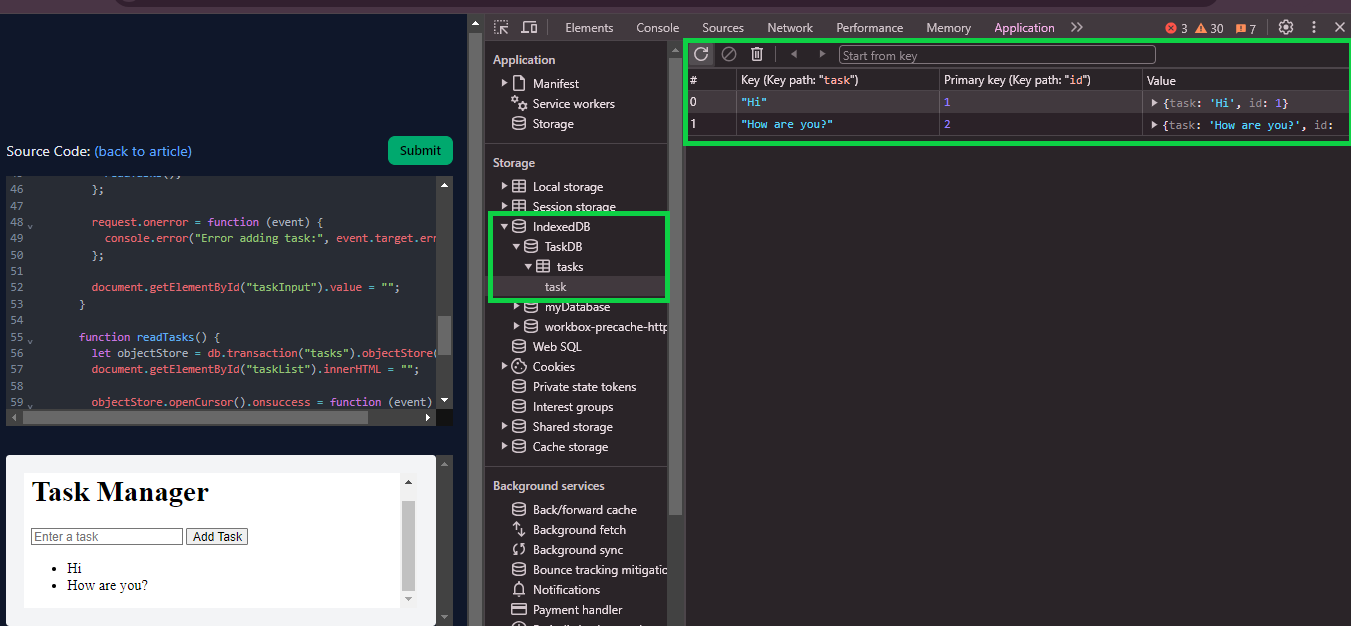IndexedDB is a powerful, client-side storage API that is more robust than other local storage solutions available in web browsers. It allows for significant amounts of structured data to be stored and manipulated asynchronously by web applications. IndexedDB is perfect for applications that require offline data storage, high performance, and rich query capabilities without reliance on a network connection.
Setting Up an IndexedDB Database
Step 1: Open a Database
To use IndexedDB, the first step is to open a database. Here is how you can create or open an IndexedDB database. Also after successful operation, we are closing and deleting the database to prevent unwanted side-effects on other examples you will run. You may skip this step in your own codes, or include it if you need.
Step 2: Creating Object Stores
Once the database is opened, you can proceed to create an object store which is akin to a table in relational databases. It's important to notice, however, that this can only be done when a new version of db is published. It means, it's either the first publishment, or when you open the db again but with another version number. The event to listen for it, is the onupgradeneeded.
Transactions
A transaction in IndexedDB is a mechanism that groups multiple operations into a single unit of work that either completely succeeds or completely fails. It is essential for ensuring data consistency and integrity, especially when multiple operations depend on each other to produce a correct outcome.
How to Use Transactions in IndexedDB
Step 1: Starting a Transaction
To perform any operation in IndexedDB, you start by creating a transaction on a database. A transaction is created by specifying which object stores the transaction will involve and the mode of the transaction, which can be either "readonly" or "readwrite".
Step 2: Accessing an Object Store
Within a transaction, you can access one or more object stores to perform data operations.
Step 3: Performing Operations
Once you have access to an object store, you can execute various operations like adding, retrieving, updating, or deleting data. Each operation returns a request object that you can use to handle success or error events.
Step 4: Completing the Transaction
A transaction will automatically complete once all the operations issued in it have been resolved, either by succeeding or failing. You can also listen for the complete event on the transaction to perform actions after all operations have successfully finished.
How to view IndexedDB content in your browser
Most modern browsers show you what is stored in the IndexedDB. Below is the example from Chrome's developer tools:

Best Practices for Using Transactions
Minimize the Scope: Keep transactions as small as possible, both in terms of the number of operations and the duration. This reduces the likelihood of conflicts and improves performance.
Error Handling: Always implement error handling on both the request and transaction levels. This helps in diagnosing issues and preventing partial updates that could lead to data corruption.
Concurrency: Understand that while IndexedDB is asynchronous and non-blocking, transactions on the same database are queued and executed serially to prevent data races and inconsistencies.
Conclusion
IndexedDB provides a robust platform for complex data management in web applications, making it an essential tool for modern web developers. Through the proper implementation of its features, developers can efficiently store, retrieve, update, and delete client-side data, enhancing application performance and user experience.
Practice Your Knowledge
Quiz Time: Test Your Skills!
Ready to challenge what you've learned? Dive into our interactive quizzes for a deeper understanding and a fun way to reinforce your knowledge.